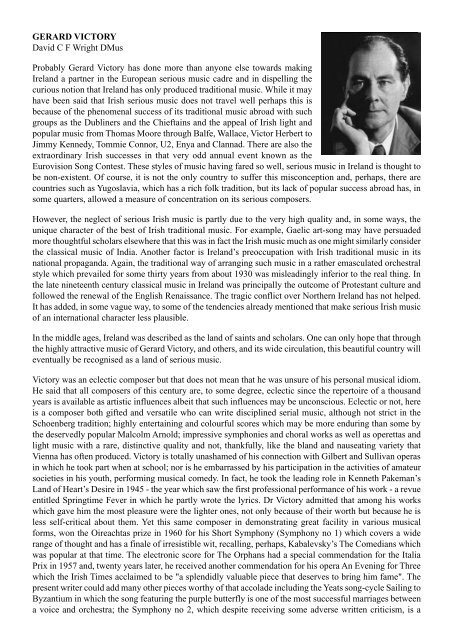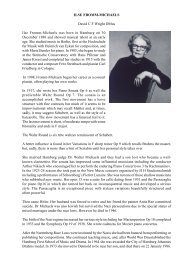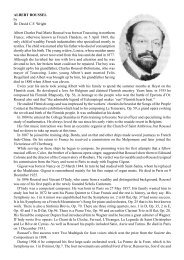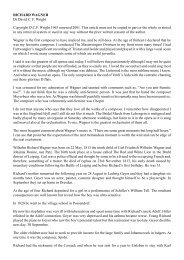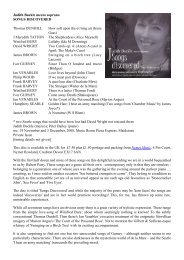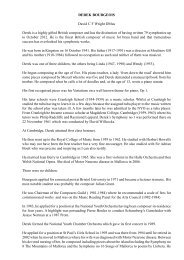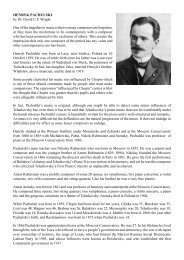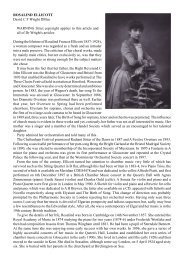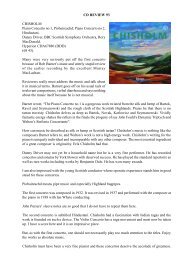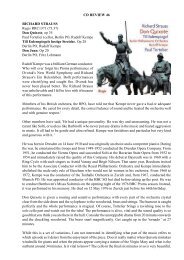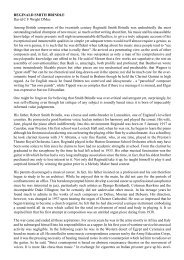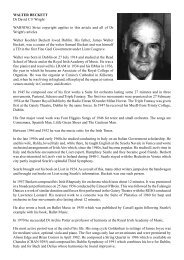Create successful ePaper yourself
Turn your PDF publications into a flip-book with our unique Google optimized e-Paper software.
GERARD VICTORY<br />
<strong>David</strong> C F <strong>Wright</strong> DMus<br />
Probably <strong>Gerard</strong> <strong>Victory</strong> has done more than anyone else towards making<br />
Ireland a partner in the European serious music cadre and in dispelling the<br />
curious notion that Ireland has only produced traditional music. While it may<br />
have been said that Irish serious music does not travel well perhaps this is<br />
because of the phenomenal success of its traditional music abroad with such<br />
groups as the Dubliners and the Chieftains and the appeal of Irish light and<br />
popular music from Thomas Moore through Balfe, Wallace, Victor Herbert to<br />
Jimmy Kennedy, Tommie Connor, U2, Enya and Clannad. There are also the<br />
extraordinary Irish successes in that very odd annual event known as the<br />
Eurovision Song Contest. These styles of music having fared so well, serious music in Ireland is thought to<br />
be non-existent. Of course, it is not the only country to suffer this misconception and, perhaps, there are<br />
countries such as Yugoslavia, which has a rich folk tradition, but its lack of popular success abroad has, in<br />
some quarters, allowed a measure of concentration on its serious composers.<br />
However, the neglect of serious Irish music is partly due to the very high quality and, in some ways, the<br />
unique character of the best of Irish traditional music. For example, Gaelic art-song may have persuaded<br />
more thoughtful scholars elsewhere that this was in fact the Irish music much as one might similarly consider<br />
the classical music of India. Another factor is Ireland’s preoccupation with Irish traditional music in its<br />
national propaganda. Again, the traditional way of arranging such music in a rather emasculated orchestral<br />
style which prevailed for some thirty years from about 1930 was misleadingly inferior to the real thing. In<br />
the late nineteenth century classical music in Ireland was principally the outcome of Protestant culture and<br />
followed the renewal of the English Renaissance. The tragic conflict over Northern Ireland has not helped.<br />
It has added, in some vague way, to some of the tendencies already mentioned that make serious Irish music<br />
of an international character less plausible.<br />
In the middle ages, Ireland was described as the land of saints and scholars. One can only hope that through<br />
the highly attractive music of <strong>Gerard</strong> <strong>Victory</strong>, and others, and its wide circulation, this beautiful country will<br />
eventually be recognised as a land of serious music.<br />
<strong>Victory</strong> was an eclectic composer but that does not mean that he was unsure of his personal musical idiom.<br />
He said that all composers of this century are, to some degree, eclectic since the repertoire of a thousand<br />
years is available as artistic influences albeit that such influences may be unconscious. Eclectic or not, here<br />
is a composer both gifted and versatile who can write disciplined serial music, although not strict in the<br />
Schoenberg tradition; highly entertaining and colourful scores which may be more enduring than some by<br />
the deservedly popular Malcolm Arnold; impressive symphonies and choral works as well as operettas and<br />
light music with a rare, distinctive quality and not, thankfully, like the bland and nauseating variety that<br />
Vienna has often produced. <strong>Victory</strong> is totally unashamed of his connection with Gilbert and Sullivan operas<br />
in which he took part when at school; nor is he embarrassed by his participation in the activities of amateur<br />
societies in his youth, performing musical comedy. In fact, he took the leading role in Kenneth Pakeman’s<br />
Land of Heart’s Desire in 1945 - the year which saw the first professional performance of his work - a revue<br />
entitled Springtime Fever in which he partly wrote the lyrics. <strong>Dr</strong> <strong>Victory</strong> admitted that among his works<br />
which gave him the most pleasure were the lighter ones, not only because of their worth but because he is<br />
less self-critical about them. Yet this same composer in demonstrating great facility in various musical<br />
forms, won the Oireachtas prize in 1960 for his Short Symphony (Symphony no 1) which covers a wide<br />
range of thought and has a finale of irresistible wit, recalling, perhaps, Kabalevsky’s The Comedians which<br />
was popular at that time. The electronic score for The Orphans had a special commendation for the Italia<br />
Prix in 1957 and, twenty years later, he received another commendation for his opera An Evening for Three<br />
which the Irish Times acclaimed to be "a splendidly valuable piece that deserves to bring him fame". The<br />
present writer could add many other pieces worthy of that accolade including the Yeats song-cycle Sailing to<br />
Byzantium in which the song featuring the purple butterfly is one of the most successful marriages between<br />
a voice and orchestra; the Symphony no 2, which despite receiving some adverse written criticism, is a
illiantly executed work; and the hugely enjoyable Three Irish Pictures which are not written in the<br />
emasculated manner of a previous generation. Of these, the third is completely original, the basic theme of<br />
the first is an Irish folk-song Ding Dong Dedero which is, in fact, a blacksmith’s work-song which, in the<br />
Irish words, hints that his wife has run off with a tailor who is, apparently, an expert dancer. The composer<br />
has represented this situation in a kind of hysterical dance followed by a sad reprise. The second picture is<br />
based on a song called The Wounded Hussar dealing with some episode in the eighteenth century where an<br />
Irish soldier lies dying on the battlefield. <strong>Victory</strong> said, "the tune interested me because it seems to have some<br />
central European effects, for example, the mixture of tonic major and minor in places". The middle section<br />
which recalls the battle is original and throughout the whole work the orchestration is faultless. When<br />
<strong>Victory</strong>’s music has travelled it has been the subject of critical acclaim; the Musical Times of December<br />
1972 said of the String Quartet "it is intricately worked and well worth hearing, filled with glorious sonorities";<br />
the Bremer Nachrichten in October 1967 remarked that the Overture Rapparee had "a beautiful natural flow<br />
– a striking but always well chosen posture".<br />
<strong>Dr</strong> <strong>Victory</strong> was born Thomas Joseph <strong>Gerard</strong> <strong>Victory</strong> on Christmas Eve 1921 in Dublin at a time of crisis in<br />
Ireland. Three weeks earlier the Anglo-Irish treaty had been signed which gave the newly-formed Irish Free<br />
State the same constitutional position that Canada had at that time with control of its own military and<br />
internal affairs but subject to an oath of loyalty to the British Crown. Tensions ran high and eventually<br />
culminated in Civil War between the pro- and anti-Treaty factions of the IRA. <strong>Gerard</strong>’s father, Thomas was<br />
a small shopkeeper, selling groceries, and in his spare time was a van-driver for the famous bakery of<br />
Johnston, Mooney and O’Brian which is now no more. He was very keen on the traditional music of Ireland<br />
and was the youngest son of a farmer in County Longford. His brother, James, was a Fianna Fail Dail<br />
Deputy, and a political activist. Although young <strong>Gerard</strong> saw his uncle often, had some admiration for him<br />
and was, in a limited measure, influenced by him, he was not to follow in his footsteps. <strong>Gerard</strong> <strong>Victory</strong> was<br />
not a party political activist but his nationalistic spirit is shown in his deep love for his country. His opinions<br />
in this direction were precise; he regretted that the Irish government has not standardized the Irish language<br />
for he believed that schools have a responsibility to transmit Irish, to encourage familiarity with the best of<br />
Irish literature, and to value the marvellous heritage.<br />
<strong>Gerard</strong>’s mother was born Delia Irwin. Her family was more secure, owning a Post Office shop in Galway.<br />
She had a good education, attending Loretto College in Balbriggan, which had good music facilities, and<br />
these became important in her life. So much so that she sent her son, at the age of six, to a Miss Lynam for<br />
piano lessons, there being no opportunities in his primary school. This teacher was a very sad individual and<br />
this melancholy affected the young student who, many years later, said that the teaching of music, particularly<br />
at lower levels, produces frustrations for the teacher which can cause feelings of failure, leading in turn, to<br />
a love/hate relationship with music. "However, this can be constructive", concluded <strong>Victory</strong>, "if it prevents<br />
complacency". This belief is shared by others including the German composer, Paul Hindemith.<br />
Another boyhood influence was the weekly Monday night visits to the Olympia Theatre. Although the<br />
music was the variety type of the 1920s its novelty and brashness made a great impression. Listening to the<br />
radio was yet another influence and opera in particular - Wagner and Mozart were great stimuli. Even at the<br />
early age of seven <strong>Gerard</strong> was aware that serious music was obviously superior in character but not so<br />
immediate to ordinary people. It is hardly surprising, therefore, that all these aspects have produced a certain<br />
oscillation in his career and work which, he claimed, may reveal his personality which is typically Irish. He<br />
always wanted to write music that communicates, not merely to compose for the experts most of whom are<br />
self-appointed. He once told the present writer, "I feel that no amount of technical brilliance is of any use<br />
unless a fairly wide audience is convinced. I place great store on casual remarks made by ordinary people<br />
who can be more revealing than so-called experts. Of course, I value most sincerely the judgement of<br />
professionals and peers including yourself."<br />
After attending private schools for three years he went to Belvedere College, Dublin from 1931 to 1939. For<br />
five years within this period he studied the piano with Louis O’Brien whose brother, Vincent, was Count<br />
John McCormack’s teacher. Such a fine teacher, coupled with young <strong>Gerard</strong>’s amazing memory, made for<br />
beneficial lessons, yet the student was told he would never make an expert pianist and that, perhaps, he
should give himself to composition. The greatest debt <strong>Victory</strong> owes to O’Brien is that music became so vital<br />
and important to him that it often excluded other activities which, from time to time, would otherwise have<br />
been more pressing. Avid listening to the radio continued, as well as collecting gramophone records and the<br />
joining of the Thomas Street public library which held scores. Here he studied Berlioz, Richard Strauss,<br />
Mahler and Stravinsky. Before reaching the age of ten he had taken out Wagner’s Meistersinger and Lohengrin<br />
but not before his mother had signed a guarantee that these two scores would be returned undamaged.<br />
<strong>Victory</strong> had a high regard for Wagner saying, "he is very hard to beat, irresistible, and the best contrapuntalist<br />
since Bach."<br />
In 1939 <strong>Victory</strong> went to University College, Dublin for four years, graduating with a Bachelor of Arts<br />
degree in Celtic studies. He also read French and German in which he had shown academic strengths from<br />
his school days. Naturally music was also pursued and in these teenage years he valued not only Wagner and<br />
Mozart but Verdi, Sullivan, Puccini and Gershwin. It was later that he developed a growing appreciation of<br />
the great symphonists. For seven years to 1946 he studied singing with Herbert Rooney who had enjoyed a<br />
good reputation in London around 1910 as a singing master. Rooney’s chief interest was in plainchant and<br />
he was, for a time, an adviser to monastic institutions in Scotland. He composed children’s cantatas such as<br />
Slumberland which may now be considered passé. His teaching methods would now be thought rather tame,<br />
especially his vocal exercises, but he was an inspiring person in other ways, rich in anecdotes about great<br />
singers he had known. He promoted the songs of York Bowen and Cyril Scott who, in the 1940s, were<br />
considered very outré.<br />
It was in 1939 that <strong>Victory</strong> produced his first attempt at composition with his Short Suite for small ensemble<br />
which he entered for the Oireachtas prize. The Oireachtas was an organisation founded around 1905 for the<br />
promotion of the Irish language and culture, with special emphasis on traditional music. It was to its credit<br />
that it extended its awards to serious music which, at the time, was regarded as alien by many of the enthusiasts<br />
of this movement. The adjudicator in 1939 was none other than Sir Hamilton Harty who was kind about<br />
<strong>Victory</strong>’s piece bearing in mind the gaucherie of it. Nonetheless a career in music had been determined in the<br />
mind of this eighteen year old. His parents were not in favour accepting his school’s recommendation that he<br />
study law or enter the Civil Service. Their lack of enthusiasm was understandable given their financial<br />
circumstances and the cultural realities in Ireland at that time.<br />
Other teachers alternated between <strong>Victory</strong>’s periods of self-tuition. Firstly, <strong>Dr</strong> John F Larchet who was a<br />
dominant personality in Ireland from 1920 to 1950. He had tremendous energy and dynamism but could be<br />
somewhat autocratic. Apart from his classical outlook which, foolishly, made his resistance to modern<br />
composers like Stravinsky absurd, he otherwise had impeccable taste. His arrangements of Irish folk music<br />
were superior to what had gone before and he was a competent composer of song and short choral works<br />
such as the Legend of Loch Leane. He was the conductor of the orchestra at the Abbey Theatre, Dublin<br />
combining such duties with directing music to accompany silent films in cinemas. He was professor of<br />
music at University College, Dublin from 1930 and <strong>Victory</strong> studied with him for about a year around 1943<br />
until his post in the Civil Service prevented this. Incidentally, Larchet has the distinction of being mentioned<br />
in James Joyce’s Finnigans Wake in the Feenichts Playhouse scene, where reference is made to music by<br />
Larchet and Laccorde.<br />
<strong>Victory</strong>’s career was a slow and circuitous one in which he acknowledged his debt to amateur music societies<br />
and the Abbey Theatre for which he composed operas and revues. His first work performed in public, albeit<br />
by such dedicated amateurs, was the operetta Nita given by the Muckross Musical Society at Matthew Hall,<br />
Dublin, in December 1944. The libretto was written by a school friend, Patrick Delahunty and the plot owes<br />
something to Ivor Novello and concerns the romance of a well-bred girl with a gypsy, a mixture of The<br />
Bartered Bride and The Gypsy Baron. The composer told me, "I remember that, ironically, during the<br />
performances of Nita, Budapest was besieged by the Russian army so the plot seemed particularly removed<br />
from reality!"<br />
The first work to receive a professional performance was a revue Spring Fever produced by the Brendan<br />
Smith Company in May 1945.
Upon leaving university, <strong>Victory</strong> became an administrative assistant in the statistics department of the Irish<br />
Civil Service. From 1948 he was variously an actor, freelance composer and arranger for Irish Radio, before<br />
becoming a talks producer in 1958, the year of what he regards his first public success, the opera The Silent<br />
Wife. His own wife was born Geraldine Herity and she married <strong>Gerard</strong> <strong>Victory</strong> on the 14 April 1948 at a<br />
Catholic church in Dublin. He was brought up as a Roman Catholic but his views on religion in recent years<br />
are somewhat perplexed and speculative. The <strong>Victory</strong>s had five children: Alma who was born in 1950;<br />
Fiona, born in 1952 who is making a successful career as an actress; Isolde, born in 1955 who is currently a<br />
Senior clerk in the House of Lords; Raymond, born in 1958, who is a doctor, specializing in anaesthetics;<br />
and Alan, born in 1962, who is an accountant.<br />
<strong>Victory</strong>’s first broadcast was incidental music to a radio play, Chinese Lantern Moon, in 1946. The moon<br />
reappears in a musical play of 1949 and broadcast the following year. Once upon a Moon is influenced by<br />
Ivor Novello as, indeed, was Nita. "Novello’s dominant influence is not as alien as it might appear," explained<br />
<strong>Victory</strong>. "Novello was a Welshman and his blend of central European sentiment is actually derived from a<br />
strong Welsh tradition of light opera forged in the last century so, perhaps, it has some fundamental link with<br />
us in Ireland."<br />
In 1950 <strong>Victory</strong> submitted a ballet suite, The Enchanted Garden, for the Carolan Prize offered by Radio<br />
Eireann. There was only one other competitor, Havelock Nelson, who won the prize with his Sinfonietta.<br />
Two years later an orchestra tried out the ballet suite and, after a few minutes the conductor shouted, "Stop.<br />
We can’t go on like this. When the Symphony Orchestra plays horrible discords like this everyone says how<br />
clever and how intellectual. When we, the Light Orchestra play them everyone says the players are all<br />
drunk."<br />
For two years from 1951 <strong>Victory</strong> studied with Walter Beckett who was about six years his senior. Beckett<br />
graduated Bachelor of Music from Trinity College, Dublin, in 1939 and became a Doctor of Music in 1947.<br />
He possessed an unusually perceptive ear for good musical comedy and advocated the use of rarer harmonic<br />
devices. <strong>Victory</strong> says that Beckett "cut me down to size usefully in some ways". In his earlier years, Beckett<br />
wrote a lot of music. His Suite for Orchestra (1945) is impressive and the finale of his Triple Fantasy is<br />
strong in character. His works then tended towards a very extensive series of orchestral suites based on Irish<br />
airs in accordance with popular demand. After a spell of teaching in England he took up composition again,<br />
his new works including a string quartet. Like many Irish composers a quest for tastefulness and decorum<br />
was at the expense of tension in his music.<br />
<strong>Victory</strong> had attended a Summer Music School in Dublin in 1950, in which the principal lecturer in composition<br />
was Alan Rawsthorne, whose critique of some of <strong>Victory</strong>’s works helped the young composer and encouraged<br />
him to study further, choosing Beckett as his teacher. Rawsthorne spotted an Elgarian tendency, a weakness<br />
which was, thankfully, soon put right; on the other hand he praised the pupil’s orchestration and was generally<br />
encouraging.<br />
Until his retirement from Radio Telefis Eireann in 1982, as for many composers, composition was a sparetime<br />
activity. Around 1953 was a good time for <strong>Victory</strong>. He was encouraged by Professor Aloys Fleischmann,<br />
who produced <strong>Victory</strong>’s Elegy in Cork in 1953, and it was also he who backed the overture Charade in 1956<br />
against great opposition. The musical climate of the 1950s, combined with other factors, was discouraging<br />
and slowed up <strong>Victory</strong>’s development. He sought further help by studying with <strong>Dr</strong> A J Potter who was born<br />
in Belfast in 1918 and had himself studied in London with Vaughan Williams. He served in the British Army<br />
during the Second World War, taking part in the Narvik expedition. He worked for a while in West Africa in<br />
the rubber industry before going to Ireland to become a vicar choral in one of the cathedrals in Dublin and<br />
then launching into a career as an arranger for the radio orchestras. He clearly had great talent and wrote<br />
much music including the television opera, Patrick (1962) about Irish immigrants in London; The Scatterin’,<br />
a sort of rock musical, but of superior quality. His chief symphonic works include Sinfonia de Profundis<br />
(1968) and a Concerto for Orchestra (1967). His comic opera, The Wedding, has a libretto written by himself.<br />
He enjoyed some measure of success in the USA who gave him several commissions. For some reason, since<br />
his death his music has been neglected and this may be due to his stylistic hallmarks being irritating to
current musicians. However, <strong>Victory</strong> found his help very important in 1959 while he was preparing to sit his<br />
Bachelor of Music examination which he successfully achieved at Trinity College, Dublin in 1960.<br />
Another major event to advance <strong>Victory</strong>’s progress was the advent of Tibor Paul as director of music at<br />
Radio Telefis Eireann who widened the horizons of acceptance of more modern idioms in Ireland and<br />
stimulated Irish composition. <strong>Victory</strong> had been studying the serial procedures of Schoenberg and in the<br />
space of a year or so he wrote four major serial works - the Prelude and Toccata for piano, Five Mantras for<br />
strings, Ballade for orchestra and the String Quartet.<br />
In 1961 <strong>Gerard</strong> <strong>Victory</strong> became a television producer at RTE, Dublin and the following year, the deputy<br />
director of music. In 1967 he became director which prestigious post he held until he retired. Other honours<br />
came his way. France awarded him the Ordre des arts et des lettres in 1975. Germany awarded him the<br />
Verdienstkreuz Order of Merit that same year. The principal reasons given for these awards were <strong>Victory</strong>’s<br />
use of French and German texts such as Verlaine, Rimbaud, de Vigny, August Stramm and others and, to<br />
some extent, his promotion of French and German music and performers. From 1981 to 1984 he was president<br />
of the International Rostrum of Composers for UNESCO in Paris. In 1975 he was awarded a Doctorate of<br />
Music from Trinity College, Dublin on the strength of his many excellent compositions. Important<br />
commissions came his way including three cantatas for the BBC music workshops between 1968 and 1971,<br />
namely The Island People, Pennine Way and Hagoromo; for the Cork International Choral Festival of 1965<br />
the Quartetto for voices and narrator and, in 1979, the Trois Chansons de Verlaine; for the Heinrich Schutz<br />
Festival in Berlin in 1965 there appeared the Hymnus Vespertinus; the European Music Year of 1985 presented<br />
the attractive Tableaux Sportifs on French radio; and for the Dublin millennium in 1988 The Land of Lilliput<br />
for youth choir, narrator, piano and two percussionists, and the Runic Variations for flute and clarinet.<br />
<strong>Dr</strong> <strong>Victory</strong> had a special affection for his orchestral work Favola di Notte which dates from 1966, the year<br />
following his visit to the Darmstadt Music School. Of all his works this one has received the most negative<br />
criticism and the composer believes it deserves a revival which would prove the critics’ initial judgement to<br />
be wrong. It is a work of great atmosphere and high drama, and is in the style of a wordless drama rather than<br />
in a traditional symphonic manner. It includes a hectic bacchanale and a passage for twenty divided strings<br />
employing a variety of contrasting playing devices.<br />
There are four numbered symphonies. The first which dates from 1962 probably established <strong>Gerard</strong> <strong>Victory</strong><br />
as a composer. The Symphony no 2, which dates from 1977, is a splendid piece in three substantial movements.<br />
It is subtitled "Il Ricorso" (The Return) taken from the writings of the Italian philosopher Giambattista Vico<br />
who believed in three dominant elements in human social affairs. Firstly the theocratic principle; secondly<br />
the artistocratic idea as typified in the Renaissance period; and thirdly the democratic age which would<br />
dissolve in a Divine thunderclap to start the cycle again. <strong>Victory</strong>’s symphony reflects these three principles.<br />
The first movement begins quietly and uneasily and leads to a climax indicating the primeval joy of man in<br />
the encircling dust of the beginning of things. Well-punctuated swirling music introduces a horn tune with a<br />
pronounced and impressive swagger; the percussion seeks to portray the march of time arriving at the age of<br />
discovery and achievement. It is music of controlled and persuasive primitivism. The character charges into<br />
a more expansive canvas with woodwind figurations and mysterious sounds as if one age were merging into<br />
another. More stirring music appears with a hint of the East and a sweeping tune which is to reappear<br />
throughout this incredible score in which orchestral colour is one of many striking features. There is also<br />
occasional grandeur and a tremendous coda with typical <strong>Victory</strong> swagger which is as infectious as it is<br />
exhilarating.<br />
The second movement is an elegy but not a sentimental one. It is tragic, suggesting cries from the heart<br />
rather than tears. Cruelty is cleverly portrayed with appropriate discordance: there are echoes of Renaissance<br />
music skilfully woven into the musical argument suggesting the sorrow at the passing of an age of artistic<br />
and cultural beauty with the realization that it will never be recaptured with its original impact. The trombone<br />
is used for its more expressive qualities. The finale is impressive and sinister. It has a strong theme and a<br />
marvellously forward motion alternating an unforgettable march theme with a waltz, contrasting declamatory<br />
utterances reminiscent of Shakespeare’s Jack Cade with whimsical entertainment. Mysterious music reappears
and an oboe theme suggests, to me at any rate, the lonely roads of Ireland. Spirituality returns with a flute<br />
solo of almost unbearable beauty heralding the repeated sweeping theme sometimes with formidable dramatic<br />
power and then with remarkable tenderness. The work ends with a spectacular coda.<br />
As well as the Symphony no 2 the 1970s saw the production of several other compositions including Jonathan<br />
Swift, a symphonic study in two movements which was completed in 1971. It has an independent symphonic<br />
structure which illustrates the sequence of Swift’s life. The opening motto, featured on the bass clarinet and<br />
horns sum up the tragic nature of Swift’s personality and echoes in its rhythms the words of his own grim<br />
epitaph "Perish the day on which I was born". There follows an extended passionate section which describes<br />
his anguish in later years and the shadow of insanity which always haunted him. The next section describes<br />
Swift’s success in the salons as a young man where his wit became famous; a parodied baroque dance<br />
illustrates the falseness of the world which for a time captivated him. The growing development of his great<br />
irony is depicted in a savage scherzando; the movement ends with a triumphal march as Swift is acclaimed<br />
by London society and as the genius before the Tory ministry of Queen Anne and the familiar of prelates and<br />
princes.<br />
The second movement depicts the despair and gloom which followed Swift’s downfall. Now Dean of St<br />
Patrick’s he becomes aware for the first time of the terrible plight of most of his Irish fellow countrymen and<br />
finds a new outlet for his gifts in opposing tyranny and corruption with perhaps the most brilliant satires ever<br />
composed. The mysterious figures of his two great loves "Stella" and "Vanessa" portrayed by the solo violin<br />
and cello weave a pattern of alternating consolation and tragedy through his later life. Percussion introduces<br />
an episode illustrating the final breakdown of his great intellect and his death is mourned in a Celtic lament<br />
by the Irish people who had now taken him to their hearts. The epilogue which is in an exhilarated mood<br />
sums up Swift’s life and work.<br />
<strong>Victory</strong>’s Piano Concerto no 2 dates from 1972, eighteen years after the first. It is in the conventional threemovement<br />
form and its harmonic and melodic language is based closely on the intervals of the opening<br />
theme, stated by the piano in octaves, which features wide leaps of minor ninths. The first movement is<br />
serious in style and relatively atonal in language; the second movement is basically a "blues"; the finale<br />
expresses a folk-music character and has a modal feeling in its melodic line and includes a set of variations<br />
and a vigorous cadenza.<br />
The Seven Songs of Experience, completed in 1977, is one of <strong>Victory</strong>’s finest choral works being settings of<br />
William Blake. The music is tonal in style which frequently displays progressions and chords built upon<br />
alternating major and minor thirds.<br />
It was in the mid-fifties that <strong>Gerard</strong> <strong>Victory</strong> first discovered the Irish air known as An Carabhat or The<br />
Cravat. The tune itself was probably written in the eighteenth century; it was composed as an appeal for<br />
peace which is equally relevant to our day. Struck by the unique qualities of the tune <strong>Victory</strong> arranged it for<br />
clarinet and piano; then, around 1979 he wrote Nine Variations on The Cravat for orchestra which include a<br />
barcarolle, a stormy, savage movement, a nocturne, a funeral march and a scherzo.<br />
The Cello Concerto of 1978 has not yet been performed. It presents a daunting but rewarding challenge to<br />
any soloist who possesses both the courage and technique to take it up.<br />
For the centenary of the birth of James Joyce, which occurred in 1982, <strong>Victory</strong> completed his Six Epiphanies<br />
of the Author for orchestra which is a symphonic study of the dualities in the life of the writer. For example,<br />
the second epiphany contrasts the opposing voices in Ireland, the fourth, the intellectual versus the sensual.<br />
This impressive score is framed by a prologue and an epilogue and each epiphany is founded upon two<br />
contrasting tonal centres drawn from the basic twelve note-row. The prologue describes Joyce’s infancy<br />
with cleverly-devised inchoate sounds. Reckless cynicism is well captured as, indeed, is the shadow of<br />
religious fear hammered out by the oboes in a relentless figure. The first epiphany is an ironic Haberna; the<br />
second is a march magnificently orchestrated as one has come to expect from <strong>Victory</strong>; the third oration and<br />
scherzo moves from moving whispers to a riotous bacchanale in which fragments of a music-hall song and
parodies of the liturgy are cleverly woven. There is a tremendous moment when the ghost of Joyce’s mother<br />
appears. The tension and drama is compulsive. The fourth epiphany is, in turn, both tranquil and menacing.<br />
The cor anglais depicts Joyce’s father singing affectedly the Irish melody The Shores of Amerikay. The fifth<br />
epiphany portrays the two sides of Joyce - the would-be man of the world and the artist. This is followed by<br />
the final epiphany, a March Macabre which echoes the earlier Habanera where the underworld, ribald laughter<br />
and menace are all portrayed with gripping realism. The epilogue echoes earlier ideas but now, for the first<br />
time, the full note-row is stated in its entirety by the solo trumpet as a tranquil arioso.<br />
As with the Symphony no 2 this work is a powerful utterance rich with its varied moods and colours, its<br />
rugged and exhilarating orchestration as well as some delightful and delicate sounds; the portrayal of the<br />
author’s life, without the need of words, is achieved with lucidity which feature had been earlier displayed<br />
with Jonathan Swift.<br />
The Symphony no 3 was completed in 1984 and is subtitled Refrains. The first movement features exotic<br />
music contending with a more tonal posture. The second has Renaissance elements and is a neo-romantic<br />
cantilena, whereas the finale is an extended march in which parodies of various march styles are set against<br />
a minimalist style in which unchanging harmony is developed by added colours and dynamics. This fine<br />
work was very well received. The Symphony no 4 is a succinct and effective work.<br />
The large Symphonic work telling the history of Dublin has been opined as his Symphony no.5<br />
On 2 March 1984 the National Concert Hall in Dublin witnessed the first performance of the mammoth ten<br />
movement Ultima Rerum which the composer described as a "global Requiem Symphony reaching beyond<br />
the traditional framework and covering a wide span of human thought on the subject of death and its aftermath".<br />
The framework is the traditional Requiem of the Roman Ritual with additional texts including the comments<br />
of non-Christian religion with quotations from the Koran, the Navajo Indians, the Norse Edda and the<br />
fantastic apocalyptic poetry of James Elroy Flecker, William Blake and Walt Whitman; elegiac writings<br />
from the ritualistic poems of the Italian sceptic Giacomo Leopardi to the poignant In Memoriam of Tennyson.<br />
Old Irish visionary literature appears in lines from Tidings of Doomsday in Lebor na hUidhre. The inclusion<br />
of such varied material may be worrying because it is unartistically unnatural and in any long work interest<br />
can be adversely affected by the diversity of material as well as the quality and changing styles of the music.<br />
For example, many admit that the symphonies of such figures as Mahler and Bruckner have superb moments<br />
but also passages that if they were not included would enhance enjoyment and overall continuity of such<br />
works. Ultima Rerum may be an unequal work but it is a magnificent achievement and concept. Many<br />
present at its first performance hailed it as "a sublime experience" even if it was sometimes a flawed rendering<br />
of the score. Perhaps the truly memorable moments of this work - and there are many - make up for the lessthan-satisfactory<br />
passages. For example, some will prefer the superior power and drama of Verdi’s Dies Irae<br />
to <strong>Victory</strong>’s. Yet for all this it is a compassionate and human work receiving lavish praise in the Irish press.<br />
The music of <strong>Gerard</strong> <strong>Victory</strong> occupies a very special place in Irish serious music and what is truly remarkable<br />
is that his light pieces such as the delightful Capriccio for violin and orchestra or the engaging short opera<br />
The Music hath mischief are not trite or banal. This composer has lifted such music out of the accusing depth<br />
of being not quite respectable to a higher level and set a higher standard in this field than ever before. Yet it<br />
is in his most serious works that there is a composer who can certainly compete with the best of contemporary<br />
composers while in a different but rewarding mode he rivals the exuberance of such figures as Malcolm<br />
Arnold.<br />
What we have in <strong>Gerard</strong> <strong>Victory</strong> is a largely unknown but distinguished and prolific composer. He has nine<br />
operas, nine works for solo instrument and orchestra, much choral and vocal music, chamber music and<br />
songs to his name. Above all, he has a marvellous and unfailing capacity for communication to which all his<br />
works testify.<br />
<strong>Dr</strong> <strong>Victory</strong> went into hospital in March 1995. A week earlier we shared our final long conversation. He<br />
sought to reassure me that his medical problem was a minor one but we both knew that it was not. He died on
14 March having bequeathed to the world a legacy of memorable music of many diverse kinds. In an obituary<br />
of this gifted composer Charles Acton wrote, "He was extremely widely read, deeply thoughtful and possessed<br />
an extraordinary ability to converse on any topic with every comma and subordinate clause impeccably in<br />
place". I can testify to that.<br />
© Copyright <strong>David</strong> CF <strong>Wright</strong> 1995.This article or any part of it must not be used, copied, downloaded,<br />
stored in any retrieval system without the prior written permission of the author. Failure to comply is<br />
illegal and will render any offendewr liable to action at law.


